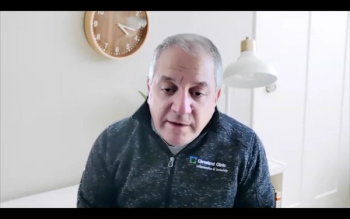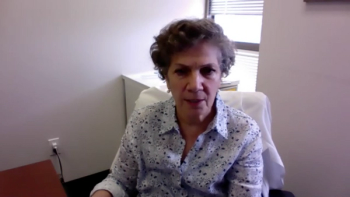
We want to use artificial intelligence (AI) to promote the best-case scenario in patient care, emphasized James Januzzi, MD, staff cardiologist at Massachusetts General Hospital.

We want to use artificial intelligence (AI) to promote the best-case scenario in patient care, emphasized James Januzzi, MD, staff cardiologist at Massachusetts General Hospital.

The e-cigarette or vaping product use–associated lung injury epidemic helped jumpstart the regulation of flavored e-cigarettes, said Laura Crotty Alexander, MD, ATSF.

There was consistent, and significant, benefit across all categories of ejection fraction—preserved, reduced, and midrange—but especially among those with preserved ejection fraction, noted Deepak L. Bhatt, MD, MPH, Brigham and Women’s Hospital Heart & Vascular Center.

Michelle M Cloutier, MD, is professor emerita at UCONN Health in Farmington, Connecticut, and chair of the National Asthma Education and Prevention Program (NAEPP) Coordinating Committee Expert Panel Working Group.

Joe Zein, MD, PhD, outlines how sex and age differences can impact asthma disease course.

Frank Martin, PhD, director of research at JDRF, discusses the organization's efforts to educate regulators about the disease.

There is a possible link between psychological distress and inflammatory markers in younger patients with a history of cardiovascular (CV) disease, specifically myocardial infarction, said Mariana Garcia, MD, cardiology fellow at Emory University.

Stephanie Lovinsky-Desir, MD, MS, discusses the importance of addressing social determinants of health (SDOH) to improve outcomes in pediatric respiratory health.

Heart failure is clearly syndromic, with several phenotypes, so it will remain challenging to reconcile patient to therapy until these unique phenotypes can be studied, stated Clyde W. Yancy, MD, MSc, of Northwestern University’s Feinberg School of Medicine.

The study looked at dapagliflozin's benefits in the acute illness setting, specifically organ protection, according to Mikhail N. Kosiborod, MD, vice president of Research at Saint Luke's Health System.

Patients with hypertrophic cardiomyopathy (HCM) had symptomatic, functional, and structural biomarker changes over the course of a little more than 6 months, explained Jay Edelberg, MD, PhD, head of Heart Failure and Cardiomyopathy Development at Bristol Myers Squibb.

ADAPTABLE was an opportunity to accomplish a large-scale study in a generalizable manner: directly involve patients, partner with them, and cocreate the program, noted Schuyler Jones, MD, associate professor of medicine at Duke University.

Farrah Kheradmand, MD, gives an overview of her research on the mechanisms of vaping-associated lung injuries.

Lou Garrison, PhD, professor emeritus in the Department of Pharmacy, University of Washington, previews the layout of the virtual 2021 ISPOR annual conference and the myriad of upcoming discussions.

Fernando Holguin, MD, explains the mechanisms that account for increased risk of pulmonary disease among individuals with metabolic syndrome.

It has been really tricky to identify and appropriately treat vaping-associated lung diseases in the time of COVID-19, said Laura Crotty Alexander, MD, ATSF.

In order to properly help patients manage their disease, it is critical for clinicians to recognize the differences in prevalence, severity, and persistency of atopic dermatitis among different demographics, said Jonathan Silverberg, MD, PhD, MPH.

Bruce House in Ottawa, Ontario, Canada, has been serving individuals living with HIV and AIDS for 33 years, and in this interview, Doug Cooper, former manager of client programs and services, discusses the history of the organization.

We’re going to celebrate and refocus on the science, reflect and share lessons learned from the pandemic, and really engage our audience in discussions that cover care guidelines and nontraditional pathways of care, said Pamela Bowe Morris, MD, chair of ACC.21.

Understanding that there is a third type of heart failure will further our understanding of the disease, noted Clyde W. Yancy, MD, MSc, chief of cardiology and vice dean for diversity and inclusion at Northwestern University's Feinberg School of Medicine.

Joe Zein, MD, PhD, discusses what to expect from his talk on sex differences in asthma at this year's American Thoracic Society (ATS) meeting.

There is a persistent gap in heart failure care regarding administration of life-saving therapies outlined in clinical practice guidelines and consensus documents, noted James Jacuzzi, MD, of Harvard Medical School and an ACC trustee.

Laura Crotty Alexander, MD, ATSF, outlines her presentation on e-cigarette or vaping product use-associated lung injury (EVALI) and other vaping diseases in the time of COVID-19 and beyond.

Michelle M Cloutier, MD, is professor emerita at UCONN Health in Farmington, Connecticut, and chair of the National Asthma Education and Prevention Program (NAEPP) Coordinating Committee Expert Panel Working Group.

William Shrank, MD, MSHS, the chief medical officer of Humana, discusses how the company is trying to overcome any vaccine hesitancy both in its workforce and in its insured member population.

As the population continues to diversify, the United States may be headed for increases in atopic dermatitis disease burden among children, said Jonathan Silverberg, MD, PhD, MPH.

Frank Martin, PhD, director of research at JDRF, discusses the importance of diabetic ketoacidosis mitigation efforts and appropriate education for parents of children with type 1 diabetes (T1D).

As atopic dermatitis (AD) prevalence has increased in children over several decades, it's critical for physicians to recognize the environmental and demographic factors contributing to the change, said Jonathan Silverberg, MD, PhD, MPH.

Frank Martin, PhD, director of research at JDRF, outlines some of the past and current efforts of the organization to support type 1 diabetes prevention therapies.

Through direct roundtable discussions between health care purchasers and physician practices, efforts have been made to align care provided in the community with the wants and needs of employees and patients.

259 Prospect Plains Rd, Bldg H
Cranbury, NJ 08512
© 2025 MJH Life Sciences®
All rights reserved.
